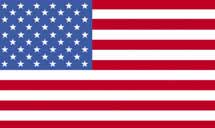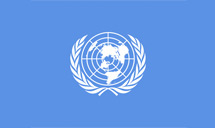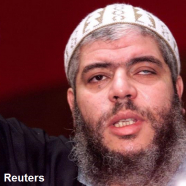Overview
Mustafa Kamel Mustafa (“Abu Hamza al-Masri” or “Abu Hamza”) is an Egyptian-British citizen and U.S.- and U.N.-sanctioned terrorist associated with al-Qaeda. He was convicted in the United States on multiple counts, including his role in a 1998 hostage-taking attack in Yemen, his support for terrorist operatives in Afghanistan, and for plotting to establish a U.S.-based al-Qaeda training camp. A longtime preacher at the Finsbury Park mosque in London, Abu Hamza was arrested in the United Kingdom in 2004 and extradited to the United States in 2012. He is currently serving two life sentences without parole at a maximum security prison in Colorado.“Mustafa Kamel Mustafa, A/k/a “Abu Hamza,” Convicted Of 11 Terrorism Charges In Manhattan Federal Court,” U.S. Department of Justice, May 19, 2014, https://www.justice.gov/usao-sdny/pr/mustafa-kamel-mustafa-aka-abu-hamza-convicted-11-terrorism-charges-manhattan-federal;
Nicky Woolf, “Abu Hamza Sentenced to Life in Prison on US Terrorism Conviction,” Guardian (London), January 9, 2015, https://www.theguardian.com/world/2015/jan/09/abu-hamza-sentenced-life-impisonment-terrorism-conviction.
Born in Alexandria, Egypt, in 1958, Abu Hamza began to show an interest in religion in the early 1980s while living on a student visa in England. There, he studied civil engineering at Brighton Polytechnic College and worked at a nightclub in London. While in England, Abu Hamza met, and ultimately married, a British woman who reportedly encouraged him to become more religiously observant.“Abu Hamza Profile,” BBC News, January 9, 2015, http://www.bbc.com/news/uk-11701269.
In 1987, Abu Hamza traveled to Mecca, Saudi Arabia, where he met with the spiritual leader of the Afghan Mujahideen movement, Abdullah Azzam.Duncan Gardham, “Nightclub Bouncer Who Became the Cleric of Hate,” Telegraph (London), February 8, 2006, http://www.telegraph.co.uk/news/uknews/1509940/Nightclub-bouncer-who-became-the-cleric-of-hate.html. By his own account, the meeting with Azzam ultimately inspired Abu Hamza to leave England in 1991 and travel to Afghanistan, where he worked on a Saudi-funded project that built factories, schools, and mosques, and provided resources to refugees in the aftermath of the Soviet-Afghan War.Duncan Gardham, “Nightclub Bouncer Who Became the Cleric of Hate,” Telegraph (London), February 8, 2006, http://www.telegraph.co.uk/news/uknews/1509940/Nightclub-bouncer-who-became-the-cleric-of-hate.html. While traveling to the region, Abu Hamza lost his eye and both of his hands, though the details of his injury are not consistent. At one point, Abu Hamza claimed to have sustained the injury while participating in a demining project in Jalalabad.“Controversial Cleric of UK Mosque,” CNN, April 1, 2003, http://www.cnn.com/2003/WORLD/europe/01/20/uk.hamzaprofile/. At his U.S. trial, however, Abu Hamza said that he was wounded while handling explosives with the Pakistani military in Lahore.“Abu Hamza Profile,” BBC News, January 9, 2015, http://www.bbc.com/news/uk-11701269.
Abu Hamza returned to England for medical treatment in 1993. Two years later, however, he left England again, this time to fight against the Serbs and Croats in Bosnia. Upon returning to London in 1995, Abu Hamza quickly became a “leading figure” in the British Islamist scene, making a name for himself by preaching and handing out leaflets urging violent jihad in the Middle East. It was during this time that Abu Hamza took up the nickname “Abu Hamza al-Masri” (“Egyptian father of the lion hunter”), and helped to organize an Islamist extremist group, the Saviours of Shariah (Islamic law).Duncan Gardham, “Nightclub Bouncer Who Became the Cleric of Hate,” Telegraph (London), February 8, 2006, http://www.telegraph.co.uk/news/uknews/1509940/Nightclub-bouncer-who-became-the-cleric-of-hate.html. In 1997, Abu Hamza began preaching at the Finsbury Park mosque in London, where he started to amass a following. In interviews in the 1990s, Hamza declared his support for the murder of non-Muslim tourists visiting countries in the Middle East. According to Abu Hamza’s own account, MI5 first contacted him around this time, after terrorists—reportedly linked to Egyptian terrorist group al-Gamaa al-Islamiya—killed 68 tourists in Luxor, Egypt, in November 1997.“Abu Hamza Profile,” BBC News, January 9, 2015, http://www.bbc.com/news/uk-11701269;
“Designation of 10 Terrorist Financiers Fact Sheet,” U.S. Department of the Treasury, April 19, 2002, https://www.treasury.gov/press-center/press-releases/Pages/po3014.aspx;
“1997: Egyptian Militants Kill Tourists at Luxor,” BBC News, accessed April 21, 2017, http://news.bbc.co.uk/onthisday/hi/dates/stories/november/17/newsid_2519000/2519581.stm.
In subsequent years, Abu Hamza gained control over the Finsbury Park mosque, delivering almost all of the sermons. According to reports, Abu Hamza’s supporters would often bar entry to the mosque to outsiders and anyone whom Abu Hamza deemed a threat.“Abu Hamza Profile,” BBC News, January 9, 2015, http://www.bbc.com/news/uk-11701269. During this time, Abu Hamza associated remotely with Yemen-based extremist figures, even claiming to serve as the “legal officer” for the al-Qaeda-affiliated Islamic Army of Aden terrorist group.“Designation of 10 Terrorist Financiers Fact Sheet,” U.S. Department of the Treasury, April 19, 2002, https://www.treasury.gov/press-center/press-releases/Pages/po3014.aspx. Abu Hamza was contacted by British police in 1999 for suspected ties to bomb plots in Yemen.“Abu Hamza Profile,” BBC News, January 9, 2015, http://www.bbc.com/news/uk-11701269.
In late December 1998, Abu Hamza participated remotely in a hostage-taking operation in Yemen that resulted in four deaths. Prior to the attack, Abu Hamza had provided the lead abductor with a satellite phone, using it to speak with the abductor both before and during the operation. On December 28, abductors stormed a caravan carrying 16 tourists, taking them hostage by force. During the attack, Abu Hamza agreed to act as an intermediary on behalf of the abductors, and continued to provide advice to the abductors over the phone.“Mustafa Kamel Mustafa, A/k/a “Abu Hamza,” Convicted Of 11 Terrorism Charges In Manhattan Federal Court,” U.S. Department of Justice, May 19, 2014, https://www.justice.gov/usao-sdny/pr/mustafa-kamel-mustafa-aka-abu-hamza-convicted-11-terrorism-charges-manhattan-federal. On December 29, during a rescue attempt by the Yemeni military, the abductors used the hostages as human shields, resulting in the deaths of four hostages and the injury of several others.“United States of America v. Mustafa Kamel Mustafa: Indictment,” U.S. Department of Justice, April 19, 2004, https://www.justice.gov/archive/usao/nys/pressreleases/October12/ChargingDocs/Mustafa,%20Mustafa%20Indictment.pdf. The attack was claimed by the Islamic Army of Aden, which would also claim credit for the USS Cole bombing in 2000.“Designation of 10 Terrorist Financiers Fact Sheet,” U.S. Department of the Treasury, April 19, 2002, https://www.treasury.gov/press-center/press-releases/Pages/po3014.aspx.
Abu Hamza continued to preach at the Finsbury Park mosque, all the while supporting terrorist operations abroad. In 1999, Abu Hamza and several co-conspirators attempted to establish an al-Qaeda training camp in the United States, based in Bly, Oregon. In late November 1999, Abu Hamza dispatched several British-based al-Qaeda operatives to establish the camp. One of the operatives, Oussama Abdullah Kassir, brought with him a manual on the use of sarin nerve gas.“Mustafa Kamel Mustafa, A/k/a “Abu Hamza,” Convicted Of 11 Terrorism Charges In Manhattan Federal Court,” U.S. Department of Justice, May 19, 2014, https://www.justice.gov/usao-sdny/pr/mustafa-kamel-mustafa-aka-abu-hamza-convicted-11-terrorism-charges-manhattan-federal. As part of the conspiracy, U.S.-based al-Qaeda operatives began to stockpile weapons and ammunition, according to U.S. court documents.“United States of America v. Mustafa Kamel Mustafa: Indictment,” U.S. Department of Justice, April 19, 2004, 6, https://www.justice.gov/archive/usao/nys/pressreleases/October12/ChargingDocs/Mustafa,%20Mustafa%20Indictment.pdf. Meanwhile, Abu Hamza also continued to work as a facilitator for foreign fighters. In November 2000, Abu Hamza began arranging safehouses and lodging in Pakistan for foreign fighters traveling to Afghanistan.“United States of America v. Mustafa Kamel Mustafa: Indictment,” U.S. Department of Justice, April 19, 2004, 11, https://www.justice.gov/archive/usao/nys/pressreleases/October12/ChargingDocs/Mustafa,%20Mustafa%20Indictment.pdf.
The Islamic Army of Aden—which claimed credit for the 1998 hostage attack—was listed by the United Nations as an organization affiliated with al-Qaeda in October 2001, after the United States designated the group as a financier of terrorism. Months later, on April 19, 2002, the U.S. Treasury Department designated Abu Hamza as a Specially Designated Global Terrorist (SDGT) in accordance with Executive Order 13224.“Designation of 10 Terrorist Financiers Fact Sheet,” U.S. Department of the Treasury, April 19, 2002, https://www.treasury.gov/press-center/press-releases/Pages/po3014.aspx. The U.N. Security Council added Abu Hamza to its list of individuals associated with al-Qaeda shortly thereafter.“Consolidated United Nations Security Council Sanctions List,” United Nations Security Council, accessed April 7, 2017, https://www.un.org/sc/suborg/en/sanctions/un-sc-consolidated-list. In explaining the reason for listing Abu Hamza, the United Nations noted that he was responsible for “recruiting” and “participating in the financing, planning, facilitating, preparing or perpetrating of acts” by the Islamic Army of Aden.“Ibrahim, Mostafa Kamel Mostafa,” Interpol, accessed April 13, 2017, https://www.interpol.int/en/notice/search/un/1419422. Despite the listing, Abu Hamza continued to preach openly in London for several years. In 2002, on the first anniversary of al-Qaeda’s 9/11 attacks, Abu Hamza co-organized a conference at the Finsbury Park mosque. During the conference, the speakers reportedly praised the 9/11 hijackers.“Abu Hamza Profile,” BBC News, January 9, 2015, http://www.bbc.com/news/uk-11701269. British authorities raided the mosque in January 2003 after discovering a terrorist plot, and seized weapons and hundreds of suspected forged or stolen identity documents and credit cards. Abu Hamza was not arrested despite the raid and temporary closure of the Finsbury Park mosque, as well as the arrest of several of its members. He continued to preach openly in London, often in the street directly facing the mosque.Duncan Gardham, “Nightclub Bouncer Who Became the Cleric of Hate,” Telegraph (London), February 8, 2006, http://www.telegraph.co.uk/news/uknews/1509940/Nightclub-bouncer-who-became-the-cleric-of-hate.html;
John Steele, Sean O’Neill, Richard Alleyne, and Sue Clough, “Police Seize Weapons in Mosque Raid,” Telegraph (London), January 21, 2003, http://www.telegraph.co.uk/news/uknews/1419533/Police-seize-weapons-in-mosque-raid.html.
Abu Hamza was arrested by British authorities in May 2004 after the United States requested his extradition to face charges. By that point, Abu Hamza had been stripped of his citizenship, according to U.K. Home Secretary David Blunkett.“Ibrahim, Mostafa Kamel Mostafa,” Interpol, accessed April 13, 2017, https://www.interpol.int/en/notice/search/un/1419422;
Duncan Gardham, “Nightclub Bouncer Who Became the Cleric of Hate,” Telegraph (London), February 8, 2006, http://www.telegraph.co.uk/news/uknews/1509940/Nightclub-bouncer-who-became-the-cleric-of-hate.html. Despite the United States’ extradition request, Abu Hamza was first tried in the United Kingdom. In February 2006, he was sentenced to seven years in prison after being convicted on sixteen criminal counts, including six counts of soliciting to murder and three counts of intending to stir up racial hatred.“Ibrahim, Mostafa Kamel Mostafa,” Interpol, accessed April 13, 2017, https://www.interpol.int/en/notice/search/un/1419422. In October 2012, after an eight-year legal battle, Abu Hamza was extradited to the United States to face terrorism-related charges. He was convicted in May 2014 of 11 terrorism-related charges and sentenced in January 2015 to life in prison without parole.“Mustafa Kamel Mustafa, A/k/a “Abu Hamza,” Convicted Of 11 Terrorism Charges In Manhattan Federal Court,” U.S. Department of Justice, May 19, 2014, https://www.justice.gov/usao-sdny/pr/mustafa-kamel-mustafa-aka-abu-hamza-convicted-11-terrorism-charges-manhattan-federal;
Joseph Ax, “London cleric Abu Hamza sentenced to life in U.S. prison,” Reuters, January 9, 2015, http://www.reuters.com/article/us-usa-security-imam-idUSKBN0KI0DA20150109.
In August 2020, Abu Hamza filed a lawsuit against the U.S. attorney general over the allegedly “cruel” conditions of his imprisonment. He claimed that the government has denied him family visits for the past eight years, and that he receives no natural light in his cell. Abu Hamza also alleged that the removal of his hooks “has left him having to tear open food packages with his rotting teeth.” He claimed that the conditions have caused him “stress and anxiety.”Zoe Tidman, “Abu Hamza Sues US Over ‘Cruel’ Prison Conditions As He Claims His Hooks Which Replace Forearms Have Been Removed,” Independent (London), August 30, 2020, https://www.independent.co.uk/news/world/americas/abu-hamza-lawsuit-us-prison-conditions-hate-preacher-finsbury-park-mosque-a9696281.html; Dipesh Gadher, “Abu Hamza Sues US Over ‘Degrading’ Jail and his Rotting Teeth,” Times, August 29, 2020, https://www.thetimes.co.uk/article/abu-hamza-sues-us-over-degrading-jail-and-his-rotting-teeth-ptr5zjm00.
“Ibrahim, Mostafa Kamel Mostafa,” Interpol, accessed April 13, 2017, https://www.interpol.int/en/notice/search/un/1419422.
Associated Groups
- Extremist entity
- Al-Qaeda
- Read Threat Report
- Type(s) of Organization:
- Non-state actor, religious, terrorist, transnational, violent
- Ideologies and Affiliations:
- Jihadist, pan-Islamist, Qutbist, Salafist, Sunni, takfiri
- Position(s):
- Recruiter, propagandist, facilitator, foreign fighter
Al-Qaeda’s 9/11 attacks was the deadliest ever on American soil, killing nearly 3,000 people. Since the fall of the Taliban, al-Qaeda has established operations worldwide, including in Syria, the Gulf, North Africa, West Africa, East Africa, and the Indian subcontinent.
History
United States

The U.S. Treasury Department designated “Abu Hamza al-Masri” as a Specially Designated Global Terrorist (SDGT) in accordance with Executive Order 13224 on April 19, 2002.“Designation of 10 Terrorist Financiers Fact Sheet,” U.S. Department of the Treasury, April 19, 2002, https://www.treasury.gov/press-center/press-releases/Pages/po3014.aspx.
United Nations

The U.N. Security Council listed “Abu Hamza al-Masri” as an individual associated with al-Qaeda on April 24, 2002.“Consolidated United Nations Security Council Sanctions List,” United Nations Security Council, accessed April 7, 2017, https://www.un.org/sc/suborg/en/sanctions/un-sc-consolidated-list.
